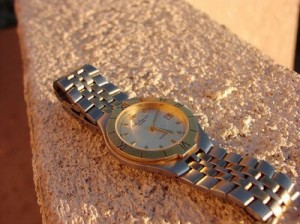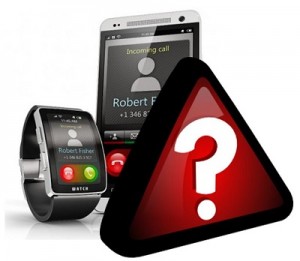This is because the product has been designed to retrofit existing pieces into wearable technology.
According to Chronos Wearables, its hardware can be used in order to create a smartwatch by retrofitting existing wristwatches, as the company claims that “the best wearable is the one you already wear.”
This device would allow both digital and traditional mechanical watches to be converted into wearable technology.
The hardware was developed by an American startup. Earlier in June, it drew a lot of attention when it demoed a technique that is called “microsuction” in order to adhere a slim disk to the back of a traditional wristwatch in order to convert it into a smartwatch. That demonstration was made at the Highway 1 accelerator’s demo day. This allows the device – and, therefore, the wristwatch attached to it – to sync with the wearer’s smartphone so that notifications can be delivered to the wearer by way of lights that appear at the edge of the wristwatch, as well as vibrations that the wearer can feel.
The conversion provides a few of the features of a smartwatch that are often seen in smart jewelry offerings.
 According to Chronos Wearables founder, Mark Nichol, “It’s a super thin disk that uses microsuction to attach to the back of your watch,” adding that “It delivers notifications from your phone, as well as tracking your health.” This indicates that it does have additional features that go above and beyond the current type of pendant wearable technology and is somewhat of an experience that is halfway between that and the latest smatwatches.
According to Chronos Wearables founder, Mark Nichol, “It’s a super thin disk that uses microsuction to attach to the back of your watch,” adding that “It delivers notifications from your phone, as well as tracking your health.” This indicates that it does have additional features that go above and beyond the current type of pendant wearable technology and is somewhat of an experience that is halfway between that and the latest smatwatches.
Nichol explained that the demonstration at Highway 1 “was our soft launch. We’ll be doing a pre-sale later this summer where we’ll be announcing exciting partnerships with some hot watch brands.” He said that 80 percent of the wristwatches that are currently on the market are compatible with the Chronos Wearables device. That said, the company is also hoping to be able to build its tech right onto wristwatch backs once it establishes some partnerships with watchmakers.
Until now, the interest in the smartwatch from consumers has been limited, even when the Apple Watch – the device that was supposed to propel this wearable technology category forward – was taken into consideration.
The Apple Watch was seen by many as the hope for the wearables sector’s future, but will it be enough?
There was a massive amount of hype before the release of the Apple Watch not only because it would be the next device from the iPhone maker, but also because many people saw the company’s entry into the market as the future of the wearable technology sector.
Now, the device has been out for a while and predictions have been diverging regarding its influence.
It is certain that the sales of those devices have been strong, and it has drawn wearable technology into the spotlight so that even people who had never heard of a smartwatch before have frequently heard of one, now. But at the same time, the majority of people still haven’t actually seen these wearables in real life. Aside from fitness trackers, most people haven’t actually experienced the use of smartwatches or smartglasses, nor have they seen them on anyone else. So analysts have been coming up with their predictions about the growth of the sector, and it seems that no two are quite alike.
The wearable technology sector is still learning about what consumers actually want from these devices.
 Among the primary complaints that had arisen about smartwatches – well before the release of the Apple Watch – was that many of them were very chunky and were not very appealing. Very few people were interested in wearing something that made them look like an extra in a made for TV sci-fi movie.
Among the primary complaints that had arisen about smartwatches – well before the release of the Apple Watch – was that many of them were very chunky and were not very appealing. Very few people were interested in wearing something that made them look like an extra in a made for TV sci-fi movie.
The offerings have smoothed out a little bit, particularly as many wearables companies have partnered up with fashion designers in order to help to make sure that consumers would feel that the devices that they had to be offer would be something that would be worth wearing. However, there have been several other issues in terms of performance that have arisen and those still have yet to be addressed.
For instance, many consumers feel that the battery life of wearables is too short. The majority of devices that are currently being sold have an average one day battery life. While it may be convenient to plug in a smartphone overnight in order to recharge it, this becomes inconvenient for smartwatch wearers as their gadgets often involve features that track their sleep.
If they have to take the wearable technology devices off, then they lose the ability to benefit from that feature. This could lead to an albeit temporary trend of using the devices overnight, but recharging them during the daytime with portable battery chargers that can be plugged in and slipped into a pocket.
 According to Chronos Wearables founder, Mark Nichol, “It’s a super thin disk that uses microsuction to attach to the back of your watch,” adding that “It delivers notifications from your phone, as well as tracking your health.” This indicates that it does have additional features that go above and beyond the current type of pendant wearable technology and is somewhat of an experience that is halfway between that and the latest smatwatches.
According to Chronos Wearables founder, Mark Nichol, “It’s a super thin disk that uses microsuction to attach to the back of your watch,” adding that “It delivers notifications from your phone, as well as tracking your health.” This indicates that it does have additional features that go above and beyond the current type of pendant wearable technology and is somewhat of an experience that is halfway between that and the latest smatwatches.
 Among the primary complaints that had arisen about smartwatches – well before the release of the Apple Watch – was that many of them were very chunky and were not very appealing. Very few people were interested in wearing something that made them look like an extra in a made for TV sci-fi movie.
Among the primary complaints that had arisen about smartwatches – well before the release of the Apple Watch – was that many of them were very chunky and were not very appealing. Very few people were interested in wearing something that made them look like an extra in a made for TV sci-fi movie.